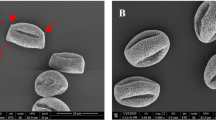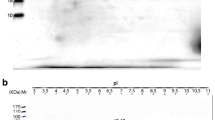Abstract
This work is aimed at characterising immunogens from Fraxinus uhdei pollen and to develop ELISA assays for their immunodetection, since it is a relevant aeroallergen. F. uhdei pollen extract contained proteins in a wide range of molecular mass from 22 to 112 kDa by SDS-PAGE; moreover, 187 fractions were detected in the 2D electrophoresis. Pollen extract was used to generate rabbit hyperimmune serum. Western blot revealed six main immunogens in a range from 40 to 21 kDa and several protein spots in 2D immunoblot. Tryptic peptides from six spots were analysed by nano-LC-ESI-MS/MS, indicating that most of proteins show homology with proteins involved in metabolism and with Ole e 11 and Fra e 2. The minimum concentration of Fraxinus spp. proteins detected by ELISA assays was 0.25 μg/mL. The detection of one 21.5 KDa protein by WB in the dust obtained from air sampling suggests the possibility to be a Fraxinus spp. protein suspended in the atmosphere. ELISA assays of the air samples detected the higher concentrations of Fraxinus spp. proteins when its airborne pollen concentrations were higher, according to the Mexican Aerobiology Network.




Similar content being viewed by others
References
Agundis, C., Pereyra, A., Zenteno, R., Brassart, C., Sierra, C., Vazquez, L., & Zenteno, E. (2000). Quantification of lectin in freshwater prawn (Macrobachium rosenbergii) hemolimph by ELISA. Comparative Biochemistry Physiology Part B, 127, 165–172.
Alpuche, J., Pereyra, A., Mendoza-Hernández, G., Agundis, C., Rosas, C., & Zenteno, E. (2010). Purification and partial characterization of an agglutinin from Octopus maya serum. Comparative Biochemistry Physiology Part B, 156, 1–5.
Barderas, R., Purohit, A., Papanikolau, I., Rodríguez, R., Pauli, G., & Villalba, M. (2005). Cloning, expression, and clinical significance of the major allergen from ash pollen, Fra e 1. Journal of Allergy and Clinical Immunology, 115, 351–357.
Barderas, R., Purohit, A., Rodríguez, R., Pauli, G., & Villalba, M. (2006). Isolation of the main allergen Fra e 1 from ash (Fraxinus excelsior) pollen: comparison of the natural and recombinant forms. Annals of Allergy, Asthma & Immunology, 96, 557–563.
Bartra, J., Mullol, J., del Cuvillo, A., Dávila, I., Ferrer, M., & Jáuregui, I. (2007). Air pollution and allergens. Journal of Investigational Allergology and Clinical Immunology, 17, 3–8.
Carnés, J., & Fernández-Caldas, E. (2002). Ole e 4 and Ole e 5, important allergens of Olea europea. Allergy, 57, 24–28.
D’Amato, G., Cecchi, L., Bonini, S., Nunes, C., Annesi-Maesano, I., Behrendt, H., et al. (2007). Allergenic pollen and pollen allergy in Europe. Allergy, 62, 976–990.
Emberlin, J. (1995). Interaction between air pollutants and aeroallergens. Clinical and Experimental Allergy, 25, 33–39.
Esteve, C., Montealegre, C., Marina, M. L., & García, M. C. (2012). Analysis of olive allergens. Talanta, 92, 1–14.
Fedorov, A. A., Ball, T., Mahoney, N. M., Valenta, R., & Almo, S. C. (1997). The molecular basis for allergen cross-reactivity: crystal structure and IgE-epitope mapping of birch pollen profilin.”. Structure, 5, 33–45.
Findlay, J. B. C., & Geisow, M. J. (1989). Protein sequencing: a practical approach (p. 199). Oxford: IRL.
Galindo, C., Torres, E., Arreola, R., & Terroba, B. (2012). Guía de árboles comunes de la Ciudad de México. México: Comisión Nacional para el Conocimiento y Uso de la Biodiversidad (CONABIO).
Hemmer, W., Focke, M., Wantke, F., Gotz, M., Jarish, R., Jager, S., & Gotz, M. (2000). Ash (Fraxinus excelsior) pollen allergy in central Europe: specific role of pollen panallergens and the major allergen of ash pollen, Fra e 1. Allergy, 55, 923–930.
Hrabina, M., Purohit, A., Oster, J. P., Papanikolau, I., Jain, K., Jain, K., et al. (2007). Standardization of an Ash (Fraxinus excelsior) Pollen Allergen Extract. International Archives of Allergy and Immunology, 142, 11–18.
Katsube, T., Kazuta, Y., Tanizawa, K., & Fukui, T. (1991). Expression in Escherichia coli of UDP-glucose pyrophosphorylase cDNA from potato tuber and functional assessment of the five lysyl residues located at the substrate-binding site. Biochemistry, 30, 8546–8551.
Kimraz, C., Yuksel, H., Bayrak, P., & Yilmaz, O. (2005). Symptoms of the olive pollen allergy: Do they really occur only in the pollination season? Journal of Investigation and Allergology Clinical Immunology, 15, 140–145.
LaemmLi, U. K. (1970). Cleavage of structural proteins during the assembly of the head of the bacteriophage T4. Nature, 227, 680–683.
Larenas, L. D., Arias, C. A., Guidos, F. G. A., & Cid, P. M. L. (2009). Alérgenos usados en las pruebas cutáneas en México. Revista Alergia Mexico, 56, 41–47.
Martín, E., Cárdaba, B., del Pozo, V., de Andrés, B., Villalba, M., Gallardo, S., et al. (1994). Ole e I: Epitope mapping, cross-reactivity with other Oleaceae pollens and ultrastructural localization. International Archives of Allergy and Immunology, 104, 160–170.
Mas, S., Torres, M., Garrido-Arandia, M., Salamanca, G., Castro, L., Barral, P., et al. (2014). Ash pollen immunoproteomics: Identification, immunologic characterization, and sequencing of 6 new allergens. Journal of Allergy and Clinical Immunology, 13, 01852–01856.
McConn, M., & Browse, J. (1993). The critical requirement for linoleic acid is pollen development, not biosynthesis, in an Arabidopsis mutant. The Plant Cell, 8, 403–416.
Metz-Favre, C., Papanikolaou, I., Purohit, A., Paulie, G., & de Blay, F. (2010). The reality of ash pollinosis. Revue Francaise D Allergologie, 50, 568–573.
Moffatt, B. A., Wang, L., Allen, M. S., Stevens, Y. Y., Qin, W., Snider, J., & von Schwartzenberg, K. (2000). Adenosine kinase of Arabidopsis. Kinetic properties and gene expression. Plant Physiology, 124(4), 1775–1785.
Morfín-Maciel, B. M., Flores, I., Rosas-Alvarado, A., Bautista, M., & López-López, J. R. (2009). Sensitization pollens of oleaceae family in a group of patients from Mexico City. Revista Alergia Mexico, 56, 194–199.
Pan, X., Chen, M., Liu, Y., Wang, Q., Zeng, L., Li, L., & Liao, Z. (2008). A new isopentenyl diphosphate isomerase gene from Camptotheca acuminata: Cloning, characterization and functional expression in Escherichia coli full length research paper. Mitochondrial DNA, 19(2), 98–105.
Poncet, P., Senechal, H., Clement, G., Purohit, A., Sutra, J. P., Desvaux, F. X., et al. (2010). Evaluation of ash pollen sensitization pattern using proteomic approach with individual sera from allergic patients. Allergy, 65, 571–580.
Reid, C. E., & Gamble, J. L. (2009). Aeroallergens, allergic disease, and climate change: Impacts and adaptation. EcoHealth, 6, 458–470.
Rodríguez, S. L. M., & Cohen, F. E. J. (2003). Guía de árboles y arbustos de la zona metropolitana de la Ciudad de México. México: REMUCEAC-GDF-UAM. D.F. 380 p.
Rounds, C. M., Winship, L. J., & Hepler, P. K. (2011). Pollen tube energetics: Respiration, fermentation and the race to the ovule. AoB Plants, 2011(plr019), 1–14.
Salamanca, G., Rodríguez, R., Quiralte, J., Moreno, C., Pascual, C. Y., Barber, D., & Villalba, M. (2010). Pectin methylesterases of pollen tissue, a major allergen in olive tree. FEBS Journal, 277, 2729–2739.
Salanoubat, M., Lemcke, K., Rieger, M., Ansorge, W., Unseld, M., Fartmann, B., et al. (2000). Sequence and analysis of chromosome 3 of the plant Arabidopsis thaliana. Nature, 408(6814), 820–822.
Salazar, F., Sewell, H. F., Shakib, F., & Ghaemmaghami, A. M. (2013). The role of lectins in allergic sensitization and allergic disease. Journal of Allergy and Clinical Immunology, 132, 27.
Salvaggio, J., Seabury, J., & Schoenhardt, E. A. (1971). New Orleans asthma. V. Relationship between Charity Hospital asthma admission rates, semiquantitative pollen and fungal spores counts, and total particulate aerometric sampling data. Journal of Allergy and Clinical Immunology, 48, 96–114.
Towbin, H., Staehelin, J., & Gordon, J. (1979). Electrophoresis transfer of proteins from polyacrylamide gels to nitrocellulose sheets: Procedure and some applications. Proceedings of National Academy of Sciences, 76, 4350–4354.
Ziska, L. H., & Caulfield, F. A. (2000). Rising CO2 and pollen production of common ragweed (Ambrosia artemisiifolia L.), a known allergy-inducing species: Implications for public health. Austrian Journal of Plant Physiology, 27, 893–898.
Acknowledgments
To Cesar Guerrero-Guerra and Miguel Menses-Pérez for their technical advice. We also thank to SECITI (PICSO12-100), PAPIIT IN204315, and IN201109-3, for their financial support.
Author information
Authors and Affiliations
Corresponding author
Rights and permissions
About this article
Cite this article
Robledo-Retana, T., Zenteno, E., Agundis-Mata, M.C. et al. Detection of immunogens from Fraxinus spp. pollen grains. Aerobiologia 31, 403–410 (2015). https://doi.org/10.1007/s10453-015-9373-7
Received:
Accepted:
Published:
Issue Date:
DOI: https://doi.org/10.1007/s10453-015-9373-7




